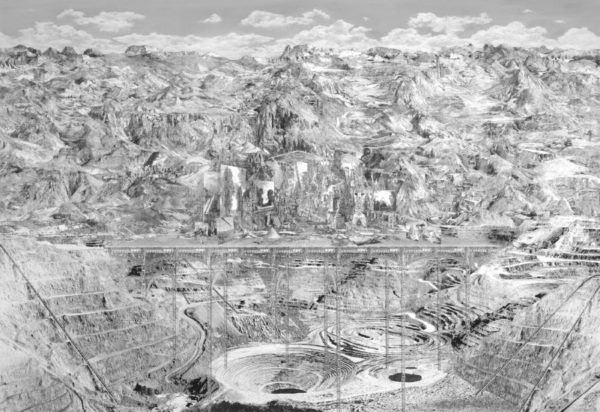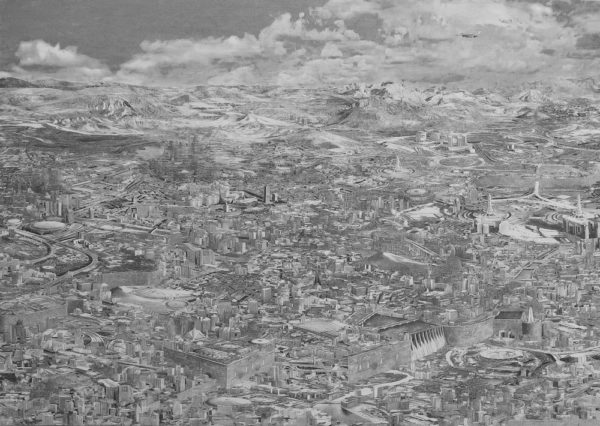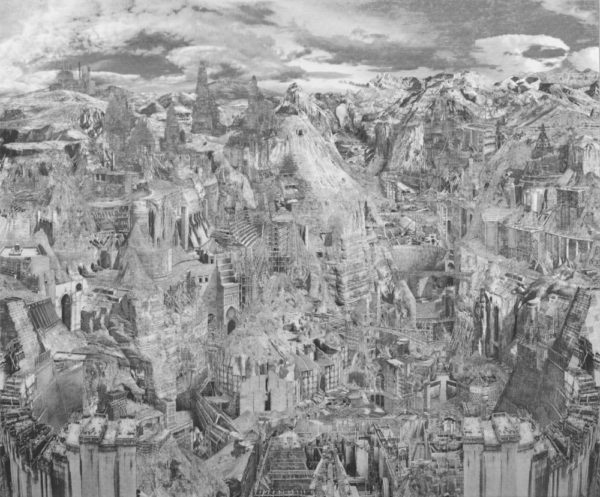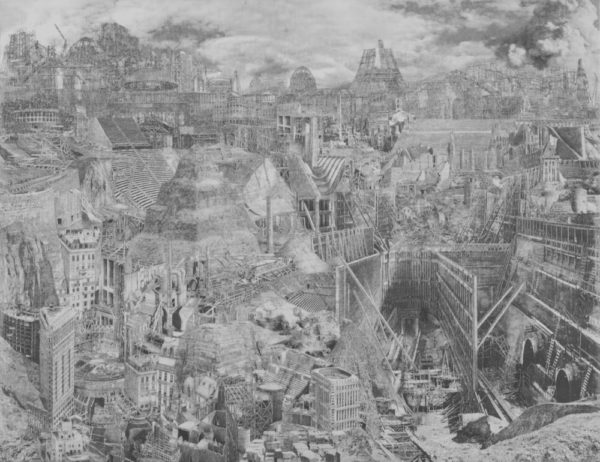Simultaneously familiar and unfamiliar, utopian and dystopian, Dean Byington’s complex canvases are the result of a meticulously refined process that is both digital and analog. Byington begins by collaging photocopies of his own drawings in parallel with fragments from 18th and 19th Century prints. The resulting montages are then scanned, printed onto clear films, and transformed into screens for silk-screening. The final images—fusions of screened oil on linen and Byington’s hand-painting—are seamless compositions made from the disparate elements.

Dean Byington, The Black Sun (2015), courtesy of the artist and Kohn Gallery.
It is impossible to take in any of the nine obsessive and hyper-detailed paintings with a single glance. Each demands close scrutiny. It is only through prolonged looking that the details and tangled narratives begin to emerge. Though they are devoid of color and people, Byington’s works weave complicated trajectories through past and present. Juxtaposing the natural and man-made worlds the pieces are designed as receding landscapes where the urban and the technological dominate the foregrounds and jagged peaks and distant vistas span the backgrounds.

Dean Byington, Minarets (2017), courtesy of the artist and Kohn Gallery.
In Bingham Canyon Mine (2017), Byington imagines a striated landscape ravaged by mining. Rebuilt into a futuristic city—part Piranesi, part Escher—the mine’s bridges and towers connect scaffold-encased structures, which jut out from stalagmite-mountains. Each part of the 40 x 48 inch painting is constructed with precision, suggesting the viability of this impossible world.

Dean Byington, Bingham Canyon Mine (2017), courtesy of the artist and Kohn Gallery.
The enticing Theory of Machines (Grand Saturn), 2017 references Edwin Church’s idealized landscape The Heart of the Andes (1859). Rather than focus on the flowing waters of the natural setting, Byington’s composition depicts huge discarded engines that hold up a platform, with a backdrop rendered as a fragment from Church’s landscape. This is in turn surrounded by other painted reproductions of nature. The crisscrossing trellises and architectural supports littering the landscape beyond Church’s fragment reflect the potential impact of industrial development.

Dean Byington, Theory of Machines (Grand Saturn) (2017), courtesy of the artist and Kohn Gallery.
Byington’s paintings are fascinating amalgamations of natural and man-made landscapes culled from depictions of what was and what could be. They are reminiscent of post apocalyptic terrains created by advanced digital technologies for today’s science fiction and horror movies. However, his environments are not made by complex algorithms, but through the analog process of careful collaging, silk-screening and hand-painting. Byington celebrates this confluence, acknowledges the coming together of high and low tech, and ultimately warns that with too much technological advancement, the inherent beauty of nature may disappear.
Dean Byington, Theory of Machines, May 19 – June 30, 2017 at Kohn Gallery, 1227 North Highland Avenue, Los Angeles, CA 90038, www.kohngallery.com


